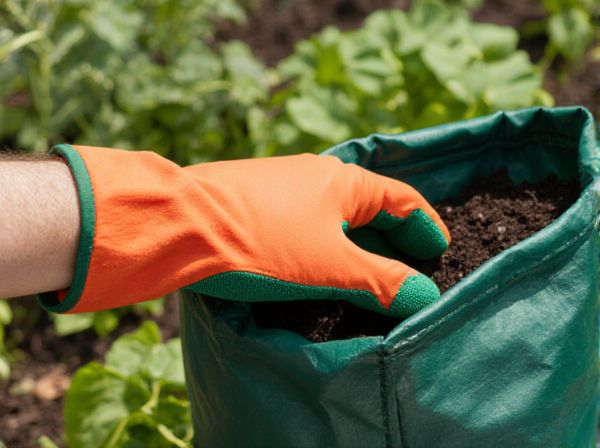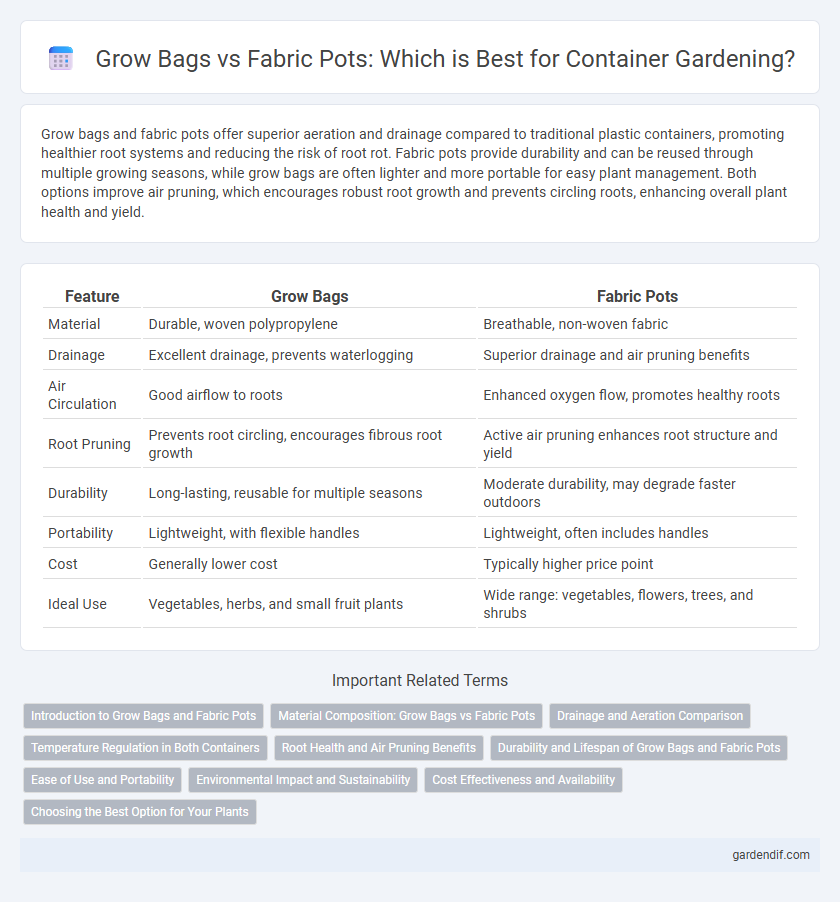
Grow bags vs fabric pots Illustration
Grow bags and fabric pots offer superior aeration and drainage compared to traditional plastic containers, promoting healthier root systems and reducing the risk of root rot. Fabric pots provide durability and can be reused through multiple growing seasons, while grow bags are often lighter and more portable for easy plant management. Both options improve air pruning, which encourages robust root growth and prevents circling roots, enhancing overall plant health and yield.
Table of Comparison
| Feature | Grow Bags | Fabric Pots |
|---|---|---|
| Material | Durable, woven polypropylene | Breathable, non-woven fabric |
| Drainage | Excellent drainage, prevents waterlogging | Superior drainage and air pruning benefits |
| Air Circulation | Good airflow to roots | Enhanced oxygen flow, promotes healthy roots |
| Root Pruning | Prevents root circling, encourages fibrous root growth | Active air pruning enhances root structure and yield |
| Durability | Long-lasting, reusable for multiple seasons | Moderate durability, may degrade faster outdoors |
| Portability | Lightweight, with flexible handles | Lightweight, often includes handles |
| Cost | Generally lower cost | Typically higher price point |
| Ideal Use | Vegetables, herbs, and small fruit plants | Wide range: vegetables, flowers, trees, and shrubs |
Introduction to Grow Bags and Fabric Pots
Grow bags and fabric pots are popular alternatives to traditional plastic containers, offering enhanced aeration and drainage for healthier root development in plant cultivation. Made from breathable, non-woven fabric materials, both grow bags and fabric pots prevent root circling and promote oxygen flow, which supports robust plant growth. These containers are designed for various gardening setups, including vegetable gardens, container plants, and urban farming, optimizing space and improving soil conditions.
Material Composition: Grow Bags vs Fabric Pots
Grow bags are typically made from non-woven polypropylene, which offers durability and breathability, while fabric pots use a high-quality felt material, often polyester or recycled fibers, enhancing aeration and water drainage. The porous nature of fabric pots promotes superior root oxygenation, preventing root circling and encouraging healthier plant development compared to grow bags. Material composition directly influences moisture retention and air flow, with fabric pots generally providing a more balanced growing environment than traditional grow bags.
Drainage and Aeration Comparison
Grow bags provide superior drainage due to their porous fabric, allowing excess water to escape easily and reducing the risk of root rot. Fabric pots also enhance aeration by promoting air pruning of roots, which encourages a healthier root system compared to traditional plastic containers. Both options improve oxygen flow to the soil, but grow bags often have better water permeability for plants requiring well-drained conditions.
Temperature Regulation in Both Containers
Grow bags and fabric pots both enhance temperature regulation by promoting airflow to the root zone, preventing overheating in warm conditions. Fabric pots typically offer superior breathability due to their woven material, which facilitates better heat dissipation and moisture evaporation. This temperature control reduces root stress and encourages healthier plant development compared to traditional plastic containers.
Root Health and Air Pruning Benefits
Grow bags and fabric pots enhance root health by promoting superior aeration and preventing root circling through effective air pruning. Their breathable materials facilitate oxygen exchange, strengthening root structure and improving nutrient uptake compared to traditional plastic containers. Air pruning naturally trims roots at the edges, encouraging a dense, fibrous root system that supports healthier plant growth.
Durability and Lifespan of Grow Bags and Fabric Pots
Grow bags are typically made from thick, durable polypropylene fabric that resists tearing and UV damage, offering a lifespan of 3 to 5 years under optimal conditions. Fabric pots, often constructed from breathable materials like felt or non-woven fabrics, may degrade faster when exposed to harsh weather but promote better root aeration and drainage. Both options provide extended usability compared to traditional plastic containers, with grow bags generally demonstrating superior durability for long-term gardening projects.
Ease of Use and Portability
Grow bags offer exceptional ease of use due to their lightweight design and flexibility, allowing gardeners to easily adjust soil volume and shape. Fabric pots provide improved portability with built-in handles, facilitating effortless movement and repositioning even when filled. Both types enhance root aeration and drainage, but grow bags are typically more maneuverable for seasonal plant transfers.
Environmental Impact and Sustainability
Grow bags and fabric pots both offer sustainable alternatives to traditional plastic containers, significantly reducing environmental footprints through their biodegradable and reusable materials. Fabric pots made from recycled fibers promote soil health by enhancing aeration and drainage, minimizing water waste and root diseases. Grow bags, often compostable, help decrease landfill waste and facilitate circular gardening practices, supporting eco-friendly cultivation.
Cost Effectiveness and Availability
Grow bags typically offer greater cost effectiveness compared to fabric pots due to their simpler design and widespread availability in garden centers and online marketplaces. Fabric pots, often made from durable materials like non-woven fabric, tend to be pricier but provide enhanced longevity and reusability for multiple growing seasons. Both options are readily available, but grow bags are generally easier to source in bulk at lower prices, making them a preferred choice for budget-conscious gardeners.
Choosing the Best Option for Your Plants
Grow bags offer superior aeration and root pruning benefits, promoting healthier root development and preventing root circling. Fabric pots provide excellent drainage and breathable material, reducing the risk of overwatering and enhancing oxygen flow to roots. Selecting between grow bags and fabric pots depends on plant type, growth stage, and environmental conditions to optimize root health and overall plant growth.
Grow bags vs fabric pots Infographic

 gardendif.com
gardendif.com